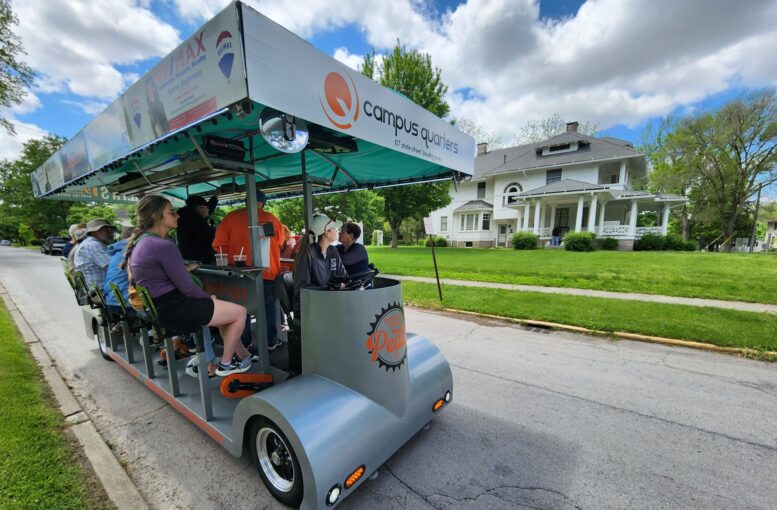By JAN McLAUGHLIN
BG Independent News
The ground rules were set soon after the history buffs put their bottoms on the bike seats and their feet on the pedals.
“In order to be a townie, your grandparents have to have been born here,” explained local historian Dick Martin, who teamed up with Geoff Howes to lead an historic tour of Bowling Green last weekend.
By that defination, the sold-out pedal tour was packed with newbies to the community.
Howes and Martin partnered with the Bowling Green Pedal Co. to wind through city streets at a top speed of 4.5 mph – close to the speed of horse and buggy rides a century ago.
For nearly 90 minutes, the pair shared stories of people who struck it rich with oil, the homes they built, the businesses they started, and the folklore they left behind.
As the pedal trolley left its home base at Arlyn’s Good Beer, it headed west on Hankey Avenue and north on Eberly Avenue. The first stop was at the “Chidester Mansion” at the corner of Eberly and West Wooster Street.
The guides greeted current owner, Chuck Codding, who was out doing yard work. Martin then regaled those on the tour with the story of the first owners, who were expecting their first child before the house had been completed. Mrs. Chidester was so determined to give birth to the baby in her upstairs bedroom, that she climbed a ladder to get up there.
Howes, a member of the city’s Historic Preservation Commission, then took over describing the home’s architecture of classic American four-square with a hipped roof and ornate porch railing, that was popular at the time and can also be seen on the porches at the Wood County Museum.
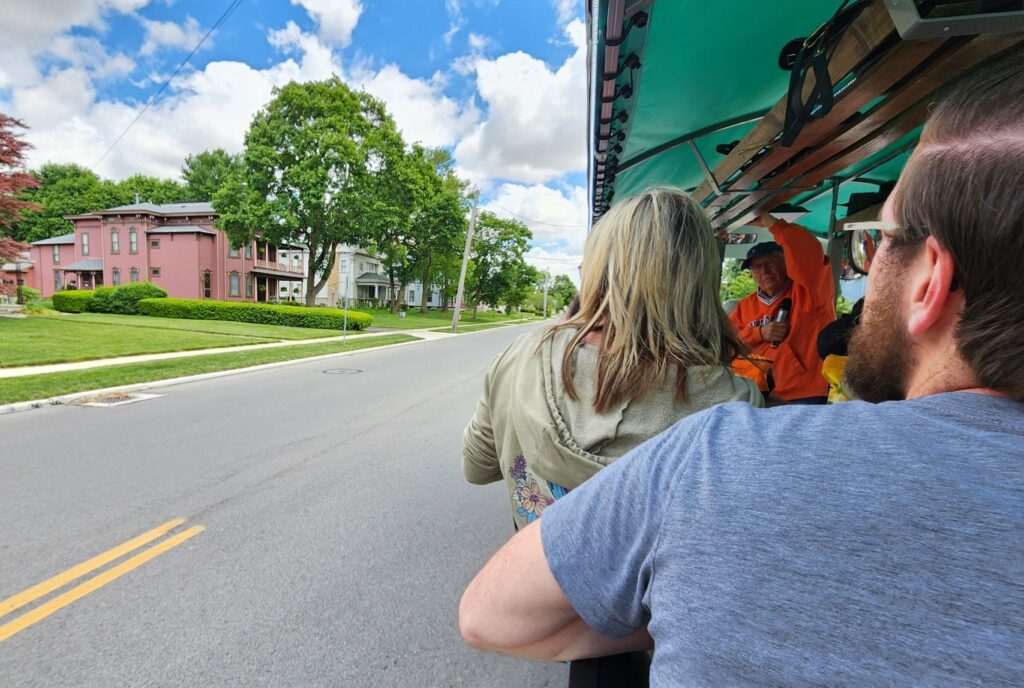
As the trolley, driven by former BGSU basketball star Mariam Justinger, turned east on West Wooster Street, the guides pointed out a couple similar-looking homes that are likely Sears Roebuck kit houses.
“They were likely delivered by train, then put together,” Martin said. The homes were popular because they were “reasonable in price,” he added.
The guides pointed out the former Wood County Children’s Detention Home, which housed up to 160 children at a time – many of them orphans.
The trolley turned north on Meeker Street, where Howes pointed out signs of the former interurban train tracks that came from Tontogany, traveled east through Bowling Green, then winded along the Portage River to Pemberville.
Back when railroad was king, Bowling Green was also home to a north-south line to Toledo and Lima.
In 1875, a group of businessmen bought a defunct steam railroad from Carroll County. With Bowling Green becoming the county seat at the same time, the city needed a way for people to get here instead of just on horseback.
“If you had a railroad, the little towns could thrive,” Martin said.
That era ended around 1930, when “cars put them out of commission,” he said.
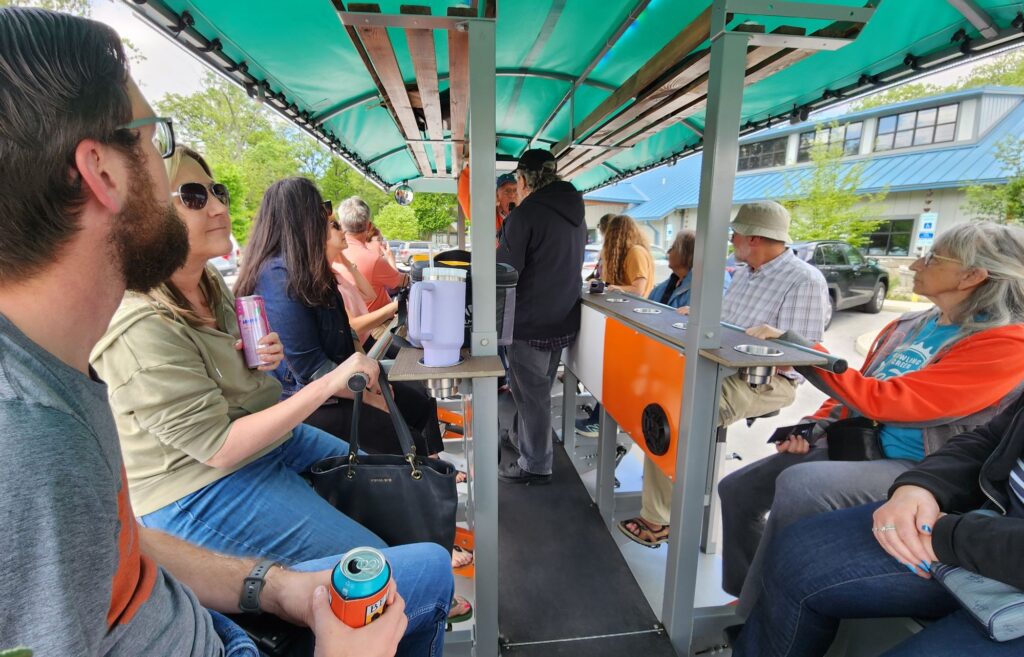
The tour then did the short loop in City Park, lined along Conneaut Avenue by the stone fence built by the Works Project Administration in the 1930s.
For a period of 45 years, from 1882 to 1927, the park was the site of the county fairgrounds. The newspaper told of “rampant crime” during fair week each year, including “pickpockets in abundance” and “hootchie-cootchie” dancers with questionable morals, Martin said.
As the pedal tour turned south onto North Maple Street, Howes pointed out Long’s drycleaning business that at one time was a factory producing ice cream and ice for “ice boxes,” a term that used to refer to refrigerators.
Across the street, the city’s water distribution offices were located in a former tricycle company, Howes said.
The pair talked about the city’s first locally designated historic district on North Maple Street. And pointed out houses throughout the city that had been moved from one location to another.
“It was not uncommon to move houses. Now we tear them down,” Martin said. He explained it used to be that construction labor was cheap while the building materials were expensive. Those roles have since reversed, he said.
As the pedal tour headed east again on West Wooster, the guides occasionally waved and called out to pedestrians by name. They directed passengers to look at the old community hospital that was built by an early physician to the city, and another house once owned by a jeweler and watchmaker.
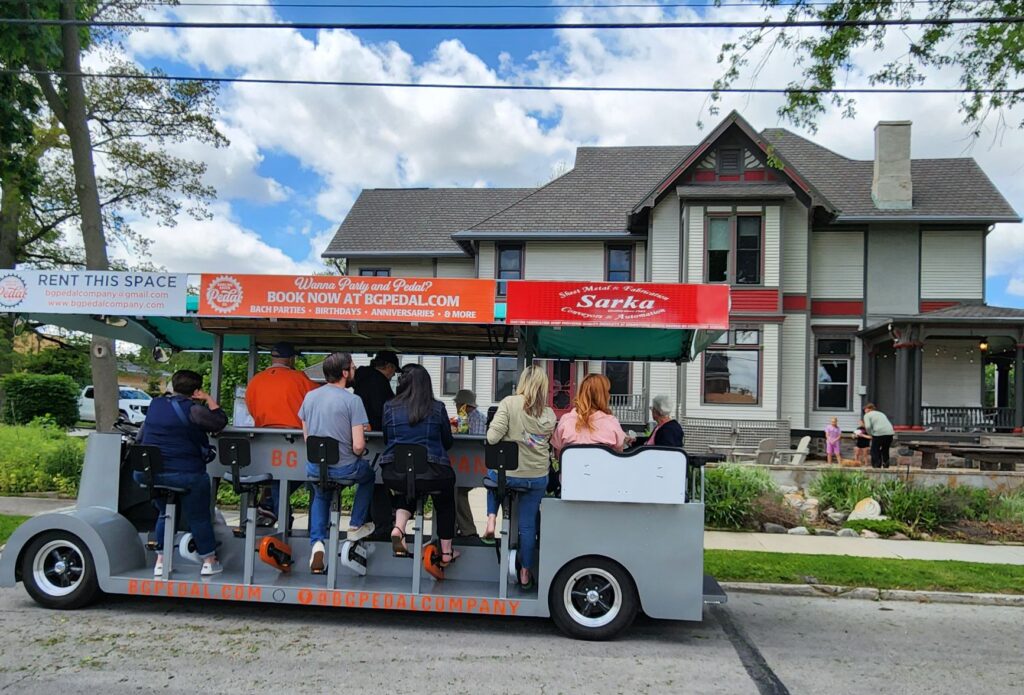
The route then turned south on South Grove Street and stopped at the historic Froney-Millikin house.
“Do you mind if we talk about your house for a little bit?” Martin yelled to the new owners, who graciously agreed. The grand old house was built by an oilman, who also owned the downtown Millikin Hotel and a department store.
The tour continued south, with Martin pointing out the last remaining brick street in the city – the extension of West Clough Street. Lyle Fletcher, a “true historian,” convinced city leaders to pass an ordinance ensuring the bricks will not be removed. Fletcher also led the effort to make sure the old downtown police station was not torn down.
Heading north on South Church Street, the guides noted First Presbyterian Church, which was originally built in 1855, destroyed by fire in 1919, and rebuilt in 1921. To bring pieces of history full circle, Martin said the intricate stained glass windows were given to the church by Mrs. Chidester-Baldwin, in memory of her son who was electrocuted while putting up an antenna – the same son she climbed the ladder to give birth to upstairs in their unfinished home.
The pedal tour then went into the downtown, with the guides noting sites once occupied by hotels, opera houses, theaters, department stores, an armory, and a YMCA. Most of the downtown buildings are 130 years old or more.
Some features remain, including the balcony at the Millikin Hotel that was once used by orators and political speakers.
They pointed out former livery stables, and ornate exteriors, such as the large sculpted bovine heads adorning the old butcher shop.
Many of the original buildings burned down – in an era when fires often swept through entire blocks before being stopped. One of the victims was the storied Hankey-Taber opera house, which boasted 1,500 seats on three balconies and the main floor. Originally built in 1898, it was devoured by fire in 1926.
As they rolled through the city, the guides listed off street names reflecting early founders and business men – like Manville, Thurstin, Baldwin, Ordway and many more.
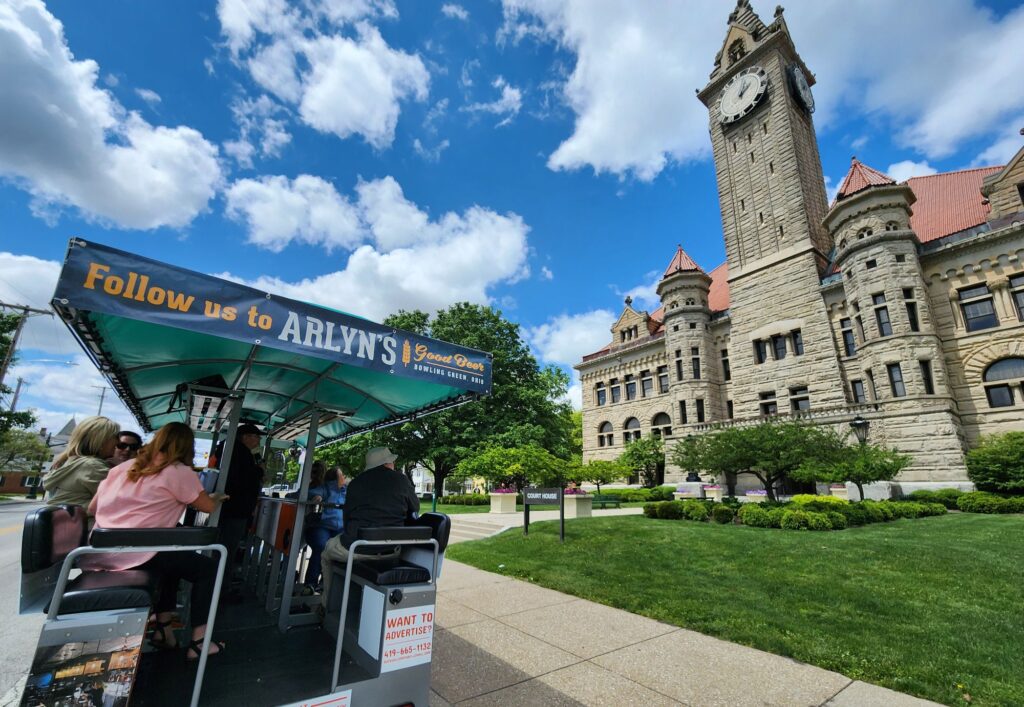
During a pause in front of the Wood County Courthouse, the guides talked about the roundabout way the county seat came to Bowling Green. When the county was first founded in 1820, the county seat was in Maumee. A couple years later, it was moved to Perrysburg.
In 1868, Bowling Green became the new county seat, but Perrysburg was not willing to relinquish its role. The newspapers in each city battled over the position of honor, and in 1875, an election was held to select the most worthy community.
Perrysburg appeared to have handily won the role. However, a vote count revealed that more than 3,000 votes were cast for Perrysburg, when there were only 1,050 eligible voters, the tour guides said.
The trolley then turned south on North Prospect Street as the guides talked about the “marriage mill” reputation in Bowling Green, where judges reportedly waived some marriage registration requirements. The most famous customer of the marriage mill was Teamsters leader Jimmy Hoffa.
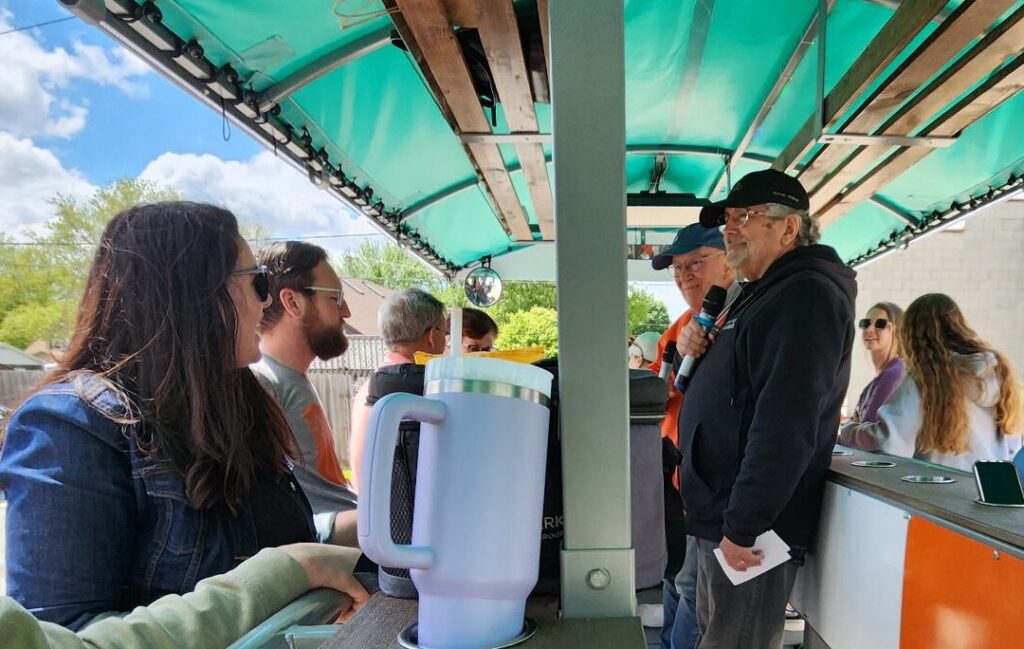
Then on South Prospect Street, near East Clough Street, the guides told the story of the shootout between Bowling Green Police and infamous gangsters Pretty Boy Floyd and Billy the Babyface Killer on April 16, 1931.
The two men were staying at a Bowling Green hotel with two women. The four were reportedly flashing money around town and dressed like mobsters.
It didn’t take long for local citizens to report the four to Bowling Green Police Chief Carl “Shorty” Galliher. Citizens were worried about them passing counterfeit money or robbing a bank.
Galliher, who wanted to bring the pair in for questioning, saw the gangsters’ car parked on Clough Street. A chase ensued, with Galliher returning fire while riding on the police car’s running boards. Bowling Green Police Officer Ralph Castner, at the wheel, was hit by gunfire.
Billy the Killer was killed, with two guns and $700 on him. One of the women was wounded, and the other was caught. But Pretty Boy Floyd got away.
Castner was taken to the hospital, where he succumbed to his injuries and died a week later.
The next two historic pedal tours are planned for June 14, at 11 a.m., and June 15, at 1:15 p.m. Register at https://bgpedalcompany.com.

